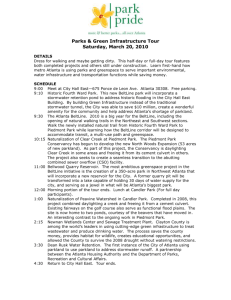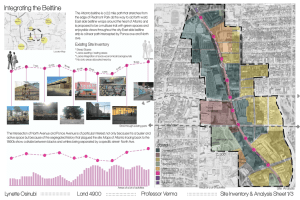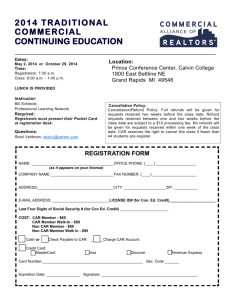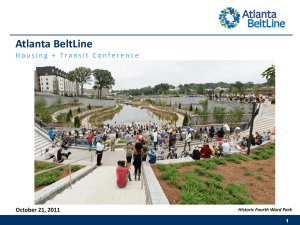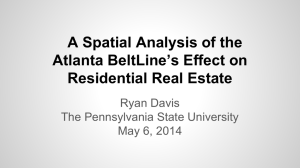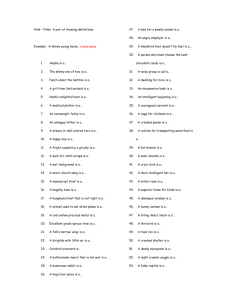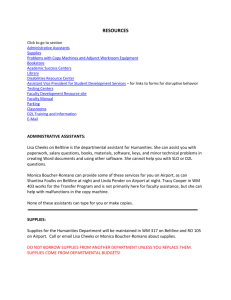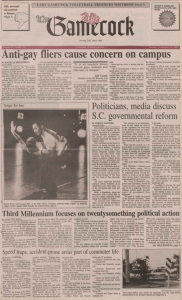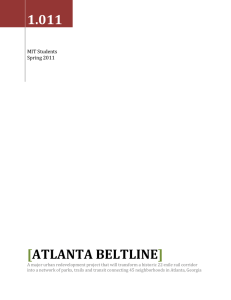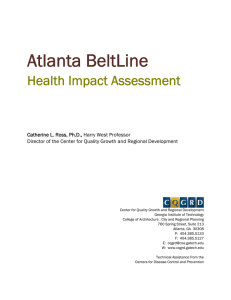Revitalizing the Atlanta Beltline
advertisement
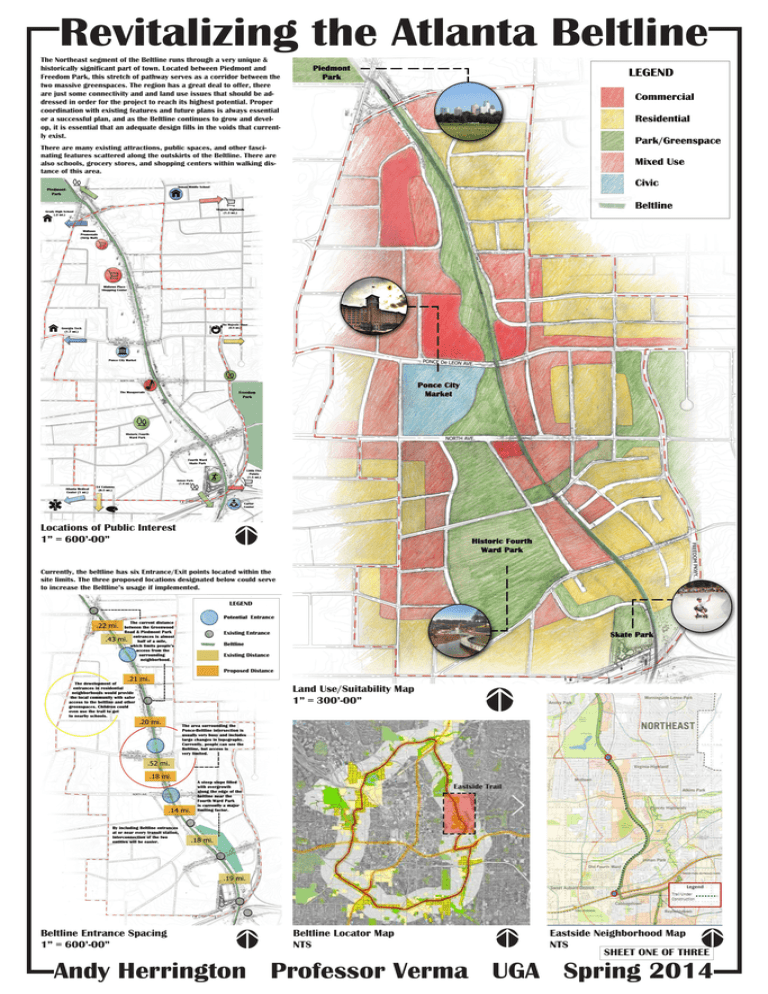
Revitalizing the Atlanta Beltline The Northeast segment of the Beltline runs through a very unique & historically significant part of town. Located between Piedmont and Freedom Park, this stretch of pathway serves as a corridor between the two massive greenspaces. The region has a great deal to offer, there are just some connectivity and and land use issues that should be addressed in order for the project to reach its highest potential. Proper coordination with existing features and future plans is always essential or a successful plan, and as the Beltline continues to grow and develop, it is essential that an adequate design fills in the voids that currently exist. There are many existing attractions, public spaces, and other fascinating features scattered along the outskirts of the Beltline. There are also schools, grocery stores, and shopping centers within walking distance of this area. Locations of Public Interest 1” = 600’-00” Currently, the beltline has six Entrance/Exit points located within the site limits. The three proposed locations designated below could serve to increase the Beltline’s usage if implemented. Land Use/Suitability Map 1” = 300’-00” Eastside Trail Beltline Entrance Spacing 1” = 600’-00” Beltline Locator Map NTS Eastside Neighborhood Map NTS SHEET ONE OF THREE Andy Herrington Professor Verma UGA Spring 2014 Revitalizing the Atlanta Beltline East Side Master Plan LOCATOR MAP The development of the Atlanta Beltline has already greatly improved many regions of the city. By taking abandoned railroads and converting them into parks and paths, the Beltline has created a series of connected public green spaces. Not only does this promote more recreational activity amongst the community, but it also inspires urban development along the new corridor. The East Side Quadrant contained an approximate grid-like street layout, which strongly contradicted the free-flowing form of the Beltline, thus creating many problematic intersections that needed to be addressed. In order to create an easy-to-navigate, pedestrian-friendly environment that is capable of bearing existing traffic patterns as well as a transit system, radial design was taken into consideration Eventually it was discovered that by establishing “center points” at the transit stop locations and radiating the plan outward, not only would this solve the issue of intersecting paths and roads, but it would change the feel of the Beltline in this region completely. It was no longer just a bicycle path and transit corridor, but rather a central artery of a larger space, drawing communities closer together. By redirecting every street to point towards the “center points,” a subtle attraction towards the Beltline, no matter where you are. The inner blocks also contain a majority of the commercial and mixed-use facilities, allowing more people to live closer to the resources they want and need. As you move away from the center the building zones transition from commercial to residential. This creates a more proportionate and fair distribution of property, and ultimately a more organized design. GREENWAY PERSPECTIVE AMPHITHEATER PERSPECTIVE MASTER PLAN 1” = 300’-00” The outer edges of the layout contain neighborhoods that bend slowly around the commercial city centers. By providing backyard access to a smaller greenway inside of these residential zones that serves as a connector path to the Beltline, this design provides safe access that requires little interaction with vehicles. That way, even people who live many blocks away from the Beltline still feel like it is just around the bend, and they may even feel more obligated to get out and exercise or at least enjoy the outdoor spaces with the rest of their community. Before, the East Side Beltline felt distant to many reaches of that part of the city. This revitalizing redesign removes this feeling, providing equal and consistent access for a two-mile stretch. That way, even visitors to the Beltline can feel comfortable navigating and experiencing the space in its entirety without getting lost. FOURTH WARD ATHLETIC FIELDS PERSPECTIVE SHEET THREE OF THREE Andy Herrington Professor Verma UGA Spring 2014 Revitalizing the Atlanta Beltline Transit Center Site Plan The redesign of the East Side Beltline called for a more organized, radial layout that revolved around center points located at the various transit stops. Therefore, these spaces needed to be capable of serving two main purposes: housing a public transportation hub and functioning as a busy central node. In order to make both of these things possible, it was imperative to find a way to connect both sides of the streetcar rail without affecting the navigational flow of the overall area. It was clear that the site needed an elevated pedestrian crossing that spanned across the gap, but steps would have contradicted my idea of a flowing pedestrian space. Therefore, it was decided it would be best to continue my radial theme inward, making yet another circular form inside of the central space. Large, gently sloping “park” ramps that curve upward towards the two endpoints of a bridge created the perfection solution to my problem with elevation change. The resulting forms and spaces are not only unique and aesthetically pleasing, but they gave the site two completely different feels, one of which can experienced in the interior, where large curving walls surround visitors as they approach the rail line. The other feel is a more dynamic one, experienced when visitors travel upward and around one of the two ramps, ultimately leading to the high point located at the bridge. As one travels higher and higher, they receive different vantage points, and eventually they are able to see the other ramp facing back at them. At that point the overall symmetry of the site becomes apparent. BRIDGE CROSSING PERSPECTIVE NSIT TRA RAIL RESTUARANT CAFE E G ID BR The hardscape is rather simple, but one feature that stands out more than most is the color gradient that can be found in the tiles. As visitors travel closer to the Beltline, they see a clear change taking place just beneath their feet. The checkerboard pattern breaks up the radial monotony while still attracting people to the center. To fill some of the voids and provide passive space, included are two large shaded staircases. These spaces offer visitors a place to sit and relax where they could still see the Beltline and the surrounding park space. Scattered throughout the site are a few water fountains. Even from a low vantage point, arches of water can be seen flying up into the air. Also included are some display areas for future artistic installments throughout the plaza area, creating an interesting place with a constantly changing character. STAIRWAY PERSPECTIVE SITE PLAN 1” = 20’-00” PLAZA PERSPECTIVE SITE PLAN SECTION 1” = 20’-00” SHEET TWO OF THREE Andy Herrington Professor Verma UGA Spring 2014
